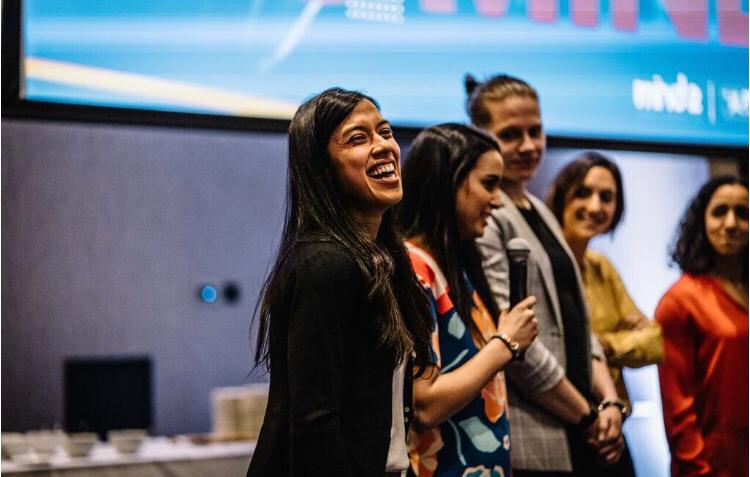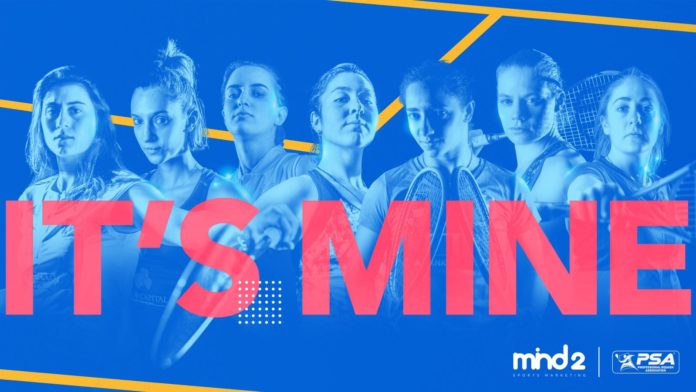It’s my resilience. It’s my passion. It’s my strength. It’s my vision. It’s my voice. It’s my risks. It’s my way.
Recently the PSA has accelerated its video output in an effort to present players in an accessible and behind-the-scenes way. Led by Nathan Clarke, they have issued twenty-odd minute-long videos entitled “A Day With….” in which they film a top player as they train and prepare for a tournament. They’ve launched “Behind the Glass” a studio show hosted by Joey Barrington and Aisling Blake (not to be confused with the leading squash podcast Outside The Glass). The show features short segments: Nathan Lake delivering milk pre-dawn in the UK; Barrington wearing full armor during an interview in France; and Nele Gilis and Paul Coll quizzing each other about their careers and interests.
The most innovative series is It’s Mine. It’s Mine is a marketing campaign run in conjunction with the PSA Foundation and Nicol David, the former world champion. Akin to “Up Close and Personal” segments that air during the Olympics, the campaign aims at injecting behind-the-scenes storytelling into the media mix.
It started with David’s retirement announcement in February during the World Championships in Chicago. Mariana de Reyes, a marketing executive from Bogota, had coffee in Chicago with fellow Colombian Adriana Olaya, the manager of the PSA Foundation. “We wanted to fill the void with Nicol leaving the tour,” Olaya said. “If Nicol is leaving—she’s been the face of women’s squash for about fifteen years—how do we help the other women on tour take ownership and a leadership role? We wanted to empower other players and give them a platform to connect with fans at a deeper level. We wanted to explain how each woman was unique. We wanted to sell the person, not the athlete.”
De Reyes played squash growing up and was a member of the Colombia junior team; she reached world No. 81 in 2005. After university, she worked for a dozen years as a brand manager and sales specialist for Phillip Morris in Bogota. She and a team of sports marketing and filmmakers in Bogota approached seven women on tour. “We wanted players who represented the diversity of the tour,” said De Reyes, “women from different continents and not all the very top players. We also wanted to elevate women who weren’t hugely adept at social media, who hadn’t fully marketed themselves. They needed showcasing.”

In April they held an inaugural meeting with the seven ambassadors in Eindhoven, during the DPD Open in the Netherlands. “I told them that we might be defined by our ranking and our titles,” David said, “but we are remembered by our values. The goal was to increase awareness about the women on tour.” They set up a WhatsApp chat group, handed out blank journals and recorded voiceovers (with towels over each woman’s head to muffle outside sound).
Then in the spring, Clarke and the PSA filmed each player. They recorded at the El Gouna International in April and the Manchester Open in early May, as well as filming on location at some of the women’s home club or back garden. In May in Hull, England, they had a final group meeting at the hotel during the British Open and then at David’s retirement dinner in Hull during the British Open, they screened an initial compilation video announcing the campaign. In September, they rolled out one video each week, culminating with Nour El Sherbini’s during the women’s World Championship at Egypt’s Pyramids of Giza.
The process of creating the films was complicated. Video was shot around the world and sent to De Reyes and her team in Bogota. “We had storyboards, brainstorm sessions and a lot of discussions,” De Reyes said. “Everyone was involved fine-tuning the film. It was very collaborative. Each of them gave thoughts about the music. Did they want voiceovers? Did they want cold beats? Did they want baby photos? We all talked about it on WhatsApp, sharing footage.”
For some players, the process involved becoming more adept with marketing themselves. For others, it was about learning how to share their stories publically. For most it was a complicated journey. They were not used to sharing. “As a pro athlete, you are taught to keep your weaknesses to yourself,” Sarah-Jane Perry said. “You try to hide everything, to present a tough exterior. You talk about the weather with the other pros, a brief hello. But the It’s Mine campaign encouraged us to look at ourselves and each other and think about our stories, who we are, how we became a top player. It was very powerful.”
The videos have lit up the Internet, as the stories resonated with squash fans around the world. Hundreds of thousands of people have viewed them, talked about them, shared them, retweeted them and liked them. Team USA star Amanda Sobhy spoke movingly about her intense recovery from injury. Raneem El Welily talked about a couple of times she had cheated on court. Nour El Tayeb discussed fighting to keep creativity in her game.
Interestingly, the most viewed and talked-about video was by Tesni Evans. She candidly spoke about body image issues and how they affected her. “I’ve never been the perfect shape,” she said in the film. “I’ve always believed that I am going to do it my way. I have other strengths that I can use. It’s not the be-all and end-all of my career. When I was a bit younger, it did affect me and I would think about it—maybe I need to be lighter? Maybe I need to be really skinny? It would get me down.”
In 2020 the It’s Mine campaign will expand. There will be panel discussions during major junior tournaments and during pro tournaments, starting with the Tournament of Champions in January, where It’s Mine ambassadors will speak about their journeys. They will start filming male players too. “It has been an amazing process,” said David. “I think It’s Mine makes sense. It has worked.”





